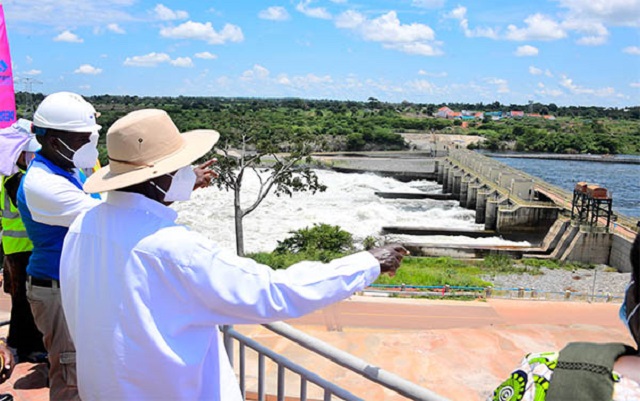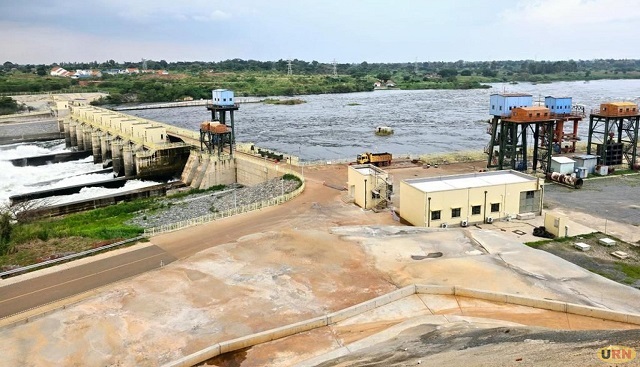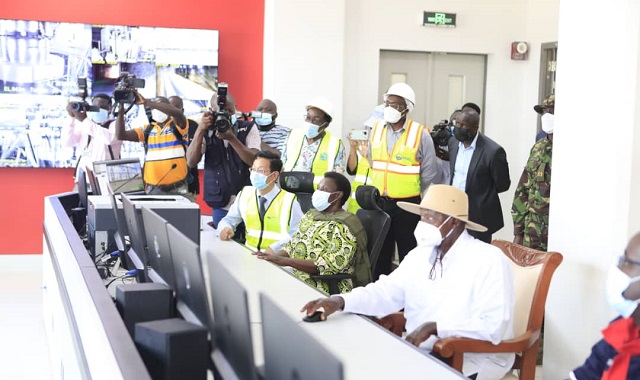
Uganda makes a major leap in energy future but more work lies a head
COVER STORY | IAN KATUSIIME | Uganda commissioned its largest hydropower project, the Karuma Hydropower Dam, on September 26, marking a significant milestone in the country’s journey towards enhanced electricity generation for both industrial growth and household access.
The commissioning of the dam comes six years after its initial completion date, delayed by contractor disputes, the COVID-19 pandemic, and regulatory hurdles. The dam, with a capacity of 600 MW, has now been successfully integrated into the national grid, boosting Uganda’s total power generation capacity to an impressive 2,000 MW.
President Yoweri Museveni, who oversaw the groundbreaking of the project in 2013, expressed his elation during the inauguration ceremony. Despite being 80 years old and with less energy than in his earlier years, Museveni took pride in witnessing the completion of such a significant infrastructure initiative, underscoring its potential to transform Uganda’s energy landscape.
In a lighthearted moment, Chinese Ambassador Zhang Lizhong extended belated birthday wishes to President Museveni, adding a festive atmosphere to the commissioning event, which felt akin to a celebratory gift for the veteran leader.
Museveni commended the Chinese contractor, Sinohydro Corporation, for their outstanding work, noting that the company had employed over 50,000 individuals throughout the eleven-year construction period. He emphasized the strong partnership between Uganda and China, with the latter financing 85% of the project through a loan from the Export-Import Bank of China.

Additionally, Museveni praised the state-owned Uganda Electricity Generation Company Limited (UEGCL) for their diligent supervision of the project, which they have managed since 2016, when they took over from the Ministry of Energy and Mineral Development.
Karuma a complex structure
The Karuma Hydropower Dam is not just a feat of engineering but also a complex project that required exceptional skills and expertise. As Africa’s largest underground power plant, its construction involved the diversion of the River Nile and the excavation of extensive tunnels. Experts have attributed previous delays to these technical complexities.
“Karuma HPP should serve as a launching pad for the development of other projects that will enable Uganda to realize its dream of achieving 52,000 MW by 2040,” said Harrison Mutikanga, CEO of UEGCL. He stressed the need for commensurate developments in transmission and distribution capacities to effectively harness this new generation potential.
The Karuma project manager, Albert Musoke Byaruhanga, reflected on the unique challenges faced during construction, which included everything from unexpected wildlife encounters to labor strikes and tense project meetings.
Electricity transmission challenges
To address transmission issues, the Karuma Interconnection Project was initiated, designed to transport electricity from the dam to various load centers across Uganda. This involved the construction of three new substations—Karuma, Kawanda, and Olwiyo—and associated transmission lines, all of which are now fully operational.
However, the construction faced numerous challenges, including instances of vandalism. In 2016, President Museveni appointed former Electoral Commission chairman Prof. Badru Kiggundu to lead a steering committee aimed at tackling these issues. Kiggundu noted that the theft of five transmission towers necessitated importing replacements from China, resulting in additional costs.
The government also faced difficulties in land acquisition and compensation as part of the Resettlement Action Plan, a process that continues as individuals are still being relocated due to the extensive nature of the project.
Originally slated for completion in 2018, the project encountered multiple setbacks. Currently, consultants will remain engaged for an additional five years during the Defects Liability Period to ensure the facility operates smoothly.
The Karuma hydropower project carries a staggering price tag of $1.4 billion, with the Ugandan government contributing 15% ($253 million) as counterpart funding. Supervised by Energy Infratech, the project included 33 subcontractors and is strategically located on the Kyoga Nile, just 2.5 km from the Masindi-Gulu Highway and 270 km from Kampala.
The main components of the plant include a dam, a powerhouse, surge chambers, pressure and cable shafts, and tailrace tunnels. Water from the hydropower plant is diverted to an underground powerhouse, which houses six Francis turbines, each coupled with generator units rated at 100 MW.
The long-awaited commissioning of the Karuma Hydropower Dam has sparked optimism for Uganda’s energy needs and its broader economic prospects. The dam is envisioned as a catalyst for the country’s industrialization agenda, which has been hindered by corruption, inconsistent economic policies, bureaucratic challenges, and a small economy reliant on foreign investment.
Experts estimate that peak electricity demand in Uganda ranges between 950 MW and 1,000 MW during evening hours. With a total installed capacity of 2,047 MW, Uganda can now increase the quantity of electricity exports to Kenya, Rwanda and Democratic Republic of Congo as well as loop in South Sudan.
President Museveni urged energy sector officials to enhance electricity consumption per capita, which currently stands at 218 kWh, emphasizing that this is achievable by lowering electricity costs.
“We used to import goods from China, but they are now scarce. Europeans were driven away due to high transport costs and expensive products,” he remarked.
Irene Batebe, Permanent Secretary at the Ministry of Energy and Mineral Development reiterated that the Karuma Hydropower Power Dam aligns with the country’s energy transition strategy.
She highlighted the country’s commitment to diversifying its energy mix, which currently relies on hydropower for 93% of its electricity generation. Uganda is targeting 24,000MW from nuclear energy alone, which would account for nearly half of its total energy mix, as approved by Cabinet last year, in the country’s energy policy that seeks to invest in long-term power generation to meet future demand.
Last year, Uganda signed a memorandum of understanding with Korea Hydro and Nuclear Power Company Ltd to build the country’s first nuclear facility, a 2,000MW plant in Buyende, eastern Uganda, estimated to cost $9 billion, according to the Ministry of Energy. The ministry’s plans also include the 840MW Ayago to be constructed in northern Uganda
The ministry is also promoting electric mobility, with the development of charging infrastructure underway, including a charging station at the ministry headquarters.
Karuma’s journey
The Karuma hydropower project has a rich history, beginning in 1995 when the Ugandan government signed a memorandum of understanding with Norwegian firm Norpark Power Limited. Following a feasibility study, it was proposed to build a 200 MW facility, taking into account the ecological sensitivity of the project site located within Murchison Falls National Park.
Years later, in 2010, following extensive consultations, the decision was made to increase the project’s capacity to 600 MW. President Museveni acknowledged Italian consultant Antonio for his role in this pivotal decision.

A wide array of technocrats and politicians have contributed to the project’s success, including Kabagambe Kaliisa, the former permanent secretary of the Ministry of Energy and Minerak Development, who played a crucial role in negotiations for financing the project. Kaliisa, who retired in 2016 after over 40 years in the ministry, attended the commissioning ceremony.
Other notable figures on the Karuma project implementation include the late Keith Muhakanizi, former permanent secretary at the Ministry of Finance, Planning and Economic Development and James Banaabe, former director of energy resources. Current and former ministers, including Syda Bumba, Hilary Onek, Irene Muloni, and Ruth Nankabirwa, have also played significant roles in the project’s development.
Kaliisa revealed that Karuma Hydropower Dam gained traction after the government hired Energy Infratech in 2009 to conduct a feasibility study that confirmed the project’s potential to generate 600 MW.
“At that time, we also established the Energy Fund for compulsory savings to kick-start project financing before approaching donors like the World Bank and the African Development Bank,” he explained.
Together with Muhakanizi, Kaliisa revealed that they presented the project as a public-private partnership to President Museveni, who granted it his approval. In 2012, the project was put out for bid, attracting nine bidders.
A breakthrough occurred in 2013 when President Museveni met with Chinese President Xi Jinping at a BRICS summit in South Africa, resulting in an agreement for the Exim Bank to finance the project. Subsequent meetings in China solidified the decision to award the construction contract to Chinese contractors.
Later in August 2013, Sinohydro signed the contract for the engineering, procurement, and construction of the hydropower plant, marking a pivotal moment in the realization of the Karuma Hydropower Dam project.
The successful commissioning of the Karuma Hydropower Dam not only highlights Uganda’s commitment to enhancing its energy capacity but also represents a significant step towards realizing the country’s long-term economic aspirations.
The commissioning of Karuma Hydropower Dam follows Isimba Hydropower Dam in Kayunga District that was commissioned in 2019. Isimba Dam was constructed at a total cost of approximately $567.7 million, with 15% of the funding provided by the Government of Uganda and the remaining 85% financed through a loan from the Export-Import Bank of China.
The construction was undertaken by the China International Water & Electric Corporation (CWE), under the supervision of the Uganda Electricity Generation Company Limited (UEGCL).
Uganda’s hydropower landscape includes several notable dams: the Nalubaale Hydropower Dam, formerly known as Owen Falls Dam, boasts an installed capacity of 180 MW; the Isimba Hydropower Dam has a capacity of 183 MW; the Kiira Hydropower Dam contributes 200 MW; and the Bujagali Hydropower Dam has an installed capacity of 250 MW.
Compared to the rest of the African countries, Ethiopia currently leads the continent as the largest power producer by wattage, generating an impressive 3,822 MW, according to the International Hydropower Association (IHA), based in London.
Following closely is South Africa, producing 3,595 MW for its population of 58 million, while Egypt ranks third with a generation capacity of 2,844 MW for its 100 million residents. Angola, with a capacity of 2,415 MW for its 30 million inhabitants, also figures prominently in the regional energy landscape.
Conversely, countries with the lowest hydropower production on the continent include South Sudan, which has no locally generated hydropower, as well as Principe and Sao Tome with just 2 MW, Central African Republic at 19 MW, Burkina Faso with 32 MW, Benin at 33 MW, and Togo with 49 MW.
 The Independent Uganda: You get the Truth we Pay the Price
The Independent Uganda: You get the Truth we Pay the Price



